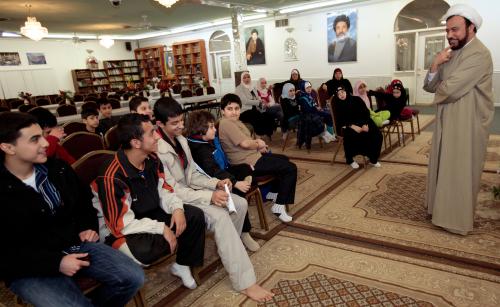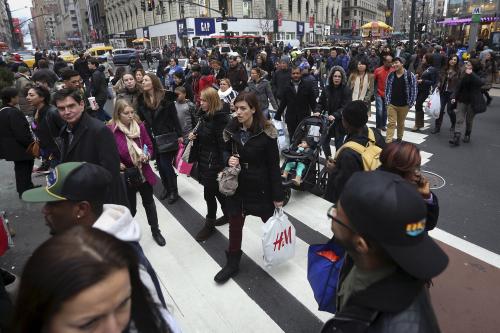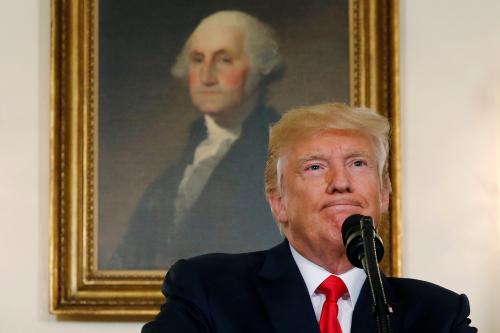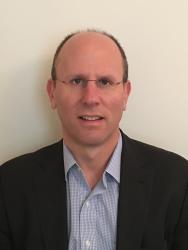Much more needs to be done to prevent the recruitment of new ISIS adherents, writes Eric Rosand, and to provide alternative pathways for those who may be drawn to the group. This post originally appeared in The Hill.
The recent release of a Congressional report highlighting that the United States is the “top target” of the Islamic State coincided with yet another gathering of members of the global coalition to counter ISIL to take stock of the effort. There, Defense Secretary Carter echoed the sentiments of an increasing number of political and military leaders when he said that military successes in Iraq and Syria, while necessary, will not be enough to diminish the threat posed by the Islamic State. So, with the United States a top target and battlefield success not an elixir, what should be done?
Particularly given the looming presidential election and the uptick in attacks inspired or directed by the Islamic State in the West and beyond, one is likely to continue to hear calls for more of the same: more police on the street, more troops on the battlefield, more rigorous screening of migrants, and more intelligence sharing. With no presidential candidate wanting to appear “soft,” the average of $11.8 million a day the Pentagon is spending each day in Iraq is likely to go up rather than down next year.
The reality, however, is that much more needs to be done to prevent the recruitment of new ISIS adherents and to provide alternative pathways for those who may be drawn to the group, but do not necessarily pose a threat and, more importantly, can be placed on another path.
We must commit ourselves to find ways to prevent disillusioned individuals from becoming motivated to join or be inspired by ISIS; only then, will we have a chance in our struggle against violent extremism. In that battle, the front lines are not manned by soldiers, drones, or intelligence officers, but by our teachers, social workers, mental health professionals, faith leaders and, perhaps most importantly, family members.
Orlando. Dhaka. Istanbul. Nice. To prevent more cities from being added to this list, we must encourage and empower those on the front lines in our communities to do more. Working with individuals that are most likely to notice the early signs of radicalization makes sense and, as we have seen in other efforts, such as those to address gang violence, it can work; they are likely to be most effective in steering an individual away from violence, including by developing programs that offer alternatives to alienated youth.
These same stakeholders are also the key to reintegrating into society those young people who may have been drawn to the messages of violent extremists but who are not deemed a security threat and for whom a jail sentence will only harden their views.
In the United States, a few, ad hoc local programs to prevent violent radicalization have (slowly) emerged in Boston, Cook County (Illinois), Los Angeles, Minneapolis, and Montgomery County (Maryland), where local officials are working with professionals, families, and others in the community to identify disillusioned young people and steer them away from violence.
This year the White House established a Department of Homeland Security-led (DHS) task force to coordinate federal countering violent extremism (CVE) efforts and DHS just announced the first-ever federal grant program (albeit for only $10 million, which is roughly the same amount available in the Netherlands, a country of less than 17 million people) to support community-based CVE initiatives. These are steps in the right direction, but on their own unlikely to catalyze the breadth and depth of a community-led effort—and attract the broad swath of non-federal government expertise—required. The federal government—led by the FBI, DHS, and Department of Justice—is perhaps ill suited to the task as we have seen in its nascent efforts in this area, (often unfairly) accused of stigmatizing Muslim communities, serving as a guise for intelligence-gathering, and violating the civil liberties of law abiding Muslim-Americans. A broader and more integrative approach to engaging community-level and non-governmental actors in this area is needed.
With the 16th anniversary of 9/11 just around the corner, and growing realization that we won’t be able to kill or arrest our away out of the problem, President Obama can mark the occasion by calling for the creation of a non-government-led “National Prevention Network” to harness the efforts of the growing number of communities and professionals around the country interested in helping to prevent the violent radicalization of individuals in their communities.
Such a network could help to mobilize resources by leveraging corporate and philanthropic contributions to support local prevention and intervention projects and involve non-law enforcement professionals around the country with experience working on CVE or related fields (e.g., drug or broader crime prevention, mental health). It could allow communities to more easily draw on the expertise from the growing number of its members and professionals (both in the United States and overseas) that need to be involved in designing and implementing “social service” prevention and intervention efforts as they move to develop their own programs, tailored to the needs of their citizens. It could help ensure that communities that don’t feel compelled to develop a full-fledged CVE program, but are interested in getting much smarter about the problem and how they can identify early signs of radicalization and steer their young people away from violence the opportunity to do so, without having to involve the “feds.” Such a network would energize professional associations of educators, community development workers, mental health and social services organizations, which have generally been reluctant to actively engage in Washington-driven CVE efforts, and create scalable partnerships with a philanthropic sector that has also been leery of involving itself in efforts that have been so closely associated with the FBI and other security actors.
A National Prevention Network will help ensure that the community-led approach to CVE that was the centerpiece of last year’s White House CVE Summit becomes a reality and is not dependent on who is in the White House or, more broadly, Washington. Although not a panacea, the network, which could draw on lessons from networks developed in other fields (e.g., human trafficking, drug addiction, and child trauma) will not only help communities in the United States, but serve as an example for other countries to follow as they look beyond the military advances in Syria and Iraq and build a “whole of society” effort to prevent terrorism.







Commentary
The U.S. needs a national prevention network to defeat ISIS
August 3, 2016